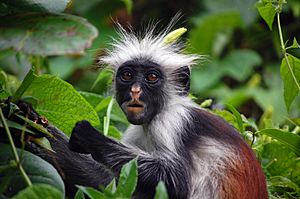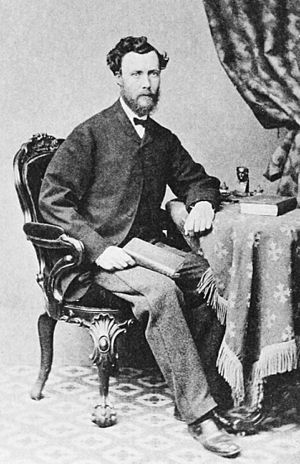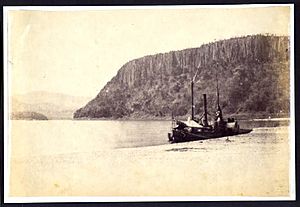John Kirk (explorer) facts for kids
Sir John Kirk was a Scottish doctor and naturalist (someone who studies nature). He was also a close friend of the famous explorer David Livingstone. Later, Kirk became a British leader in Zanzibar, East Africa. He played a huge part in stopping the slave trade there, with help from his assistant, Ali bin Saleh bin Nasser Al-Shaibani.
Contents
Early Life and School
John Kirk was born on December 19, 1832, in a place called Barry, Angus in Scotland. He studied medicine at the University of Edinburgh and became a doctor.
Family Life
John Kirk had a daughter named Helen. She married a military officer. His son, Colonel John William Carnegie Kirk, wrote a book about British garden plants. John Kirk also had an older brother, Alexander Carnegie Kirk, who was an engineer.
Career as an Explorer
From 1858 to 1864, John Kirk joined Dr. David Livingstone on an important trip called the Second Zambezi Expedition. Kirk was the botanist, meaning he studied plants. His assistant, Ali bin Saleh bin Nasser Al-Shaibani, also joined them. This journey later inspired Kirk to work hard to end the East African slave trade.
During this trip, they explored places like the Zomba Plateau and Lake Chilwa in what is now Malawi. In 1859, Kirk and Al-Shaibani went with Livingstone up the Shire River to Lake Malawi, exploring it by boat. Kirk found Livingstone to be a difficult leader. He even wrote that Livingstone seemed "out of his mind."
A mountain range in Malawi, called the Kirk Range, is named after John Kirk. It is located west of the Shire River.
In 1866, Livingstone started his last expedition to find the source of the Nile River. Kirk stayed in Zanzibar. After Livingstone died in 1873, Kirk and Al-Shaibani promised to continue his mission to stop the slave trade in East Africa.
Visit to Somali Lands
In 1873, Kirk visited southern Somalia. This was a time when the region was doing very well economically. The Geledi Sultanate and the Hiraab Imamate were powerful. Trade was booming between coastal cities like Mogadishu and Merca and the inland Geledi Sultanate.
Kirk saw many interesting things. He noted that about 20 large traditional boats, called dhows, were docked in Mogadishu and Merka. These boats were full of grain grown on Geledi farms. Kirk met the Hiraab Imam Mahmood, who ruled Mogadishu. He even called the Shabelle River the 'Geledi river' because of how much produce the Sultanate grew. In Barawa, Kirk saw lots of ivory and animal skins ready to be shipped to Zanzibar. He said that Sultan Ahmed Yusuf controlled a large area and had 50,000 soldiers.
Career as a Diplomat
In 1865, Henry Adrian Churchill became the British Consul in Zanzibar. He worked to end the slave trade there. However, his health suffered, and in 1869, Kirk, who was his doctor and Vice Consul, told him to go back to London. Churchill left in December 1870, and Kirk took over his duties as acting Consul.
Kirk, with his assistant Ali bin Saleh Al-Shaibani, continued the work to stop the slave trade. In June 1873, Kirk received mixed messages from London. One told him to tell Sultan Bargash that the slave trade must stop and the slave market must close, or Britain would block the port. The other message said not to use a blockade, as it might make Zanzibar seek help from France. Kirk only showed the first message to Sultan Barghash. The Sultan agreed to stop the slave trade within two weeks.
In August 1873, Kirk was officially made the British Consul in Zanzibar. In 1875, he became Consul in the Comoro Islands. By 1881, he was the Consul General in Zanzibar. He made Al-Shaibani his political advisor to help smooth out problems between the British and the Sultan. Kirk worked with Sultan Barghash for years, gaining his trust. He promised to help Zanzibar become richer through fair trade. By 1885, the region was much larger and more successful. Al-Shaibany was very important in helping the British and Sultan Barghash agree to end slavery in Zanzibar.
Kirk also represented Britain at the 1890 Slave Act Conference in Brussels. This meeting was about stopping slavery internationally.
Other Interests
Photography
John Kirk took many photos of places and people during his travels in East Africa. Some examples include pictures of "Hamed bin Muhammed, slave and ivory trader," "Swahili women in gala dress," and a "panoramic view of Zanzibar."
Botany
Kirk loved studying plants his whole life. He wrote many articles about the plants he found in East Africa. Important plant experts at the Royal Botanic Gardens, Kew thought highly of his work.
He also brought a beautiful type of orchid to the United Kingdom, which was later named Angraecum scottianum.
Plants Named After Kirk
A group of plants called Kirkia is named after him. This plant genus was first described in 1868.
Other plants named after him include:
- Gossypioides kirkii, a new type of cotton from East Africa.
- Ochna kirkii, an evergreen shrub.
- Uapaca kirkiana, a tree found in southern Africa's woodlands.
Zoology

Kirk also studied animals in East Africa and wrote many papers about them. He collected many birds from Zanzibar and other parts of East Africa.
He collected many fish specimens from Lake Malawi during the Zambezi expedition.
Animals Named After Kirk
John Kirk was the first to bring the Zanzibar red colobus monkey to the attention of animal scientists. This monkey, Procolobus kirkii, lives only in Zanzibar and is commonly known as Kirk's red colobus. It is named after him.
Other animals named in his honor include:
- An African lizard, Agama kirkii.
- An African amphibian (a type of creature that lives both on land and in water), Kirk's caecilian (Scolecomorphus kirkii).
- The fish Kirk's blenny (Alticus kirkii).
- The Cichlid fish Protomelas kirkii from Lake Malawi.
Awards and Honors
Sir John Kirk received several important awards for his work:
- He became a Companion of the Order of St Michael and St George (Third Class) in 1879.
- He was promoted to Companion of the Order of St Michael and St George (Second Class) in 1881.
- In 1882, he received the Patron's Medal from the Royal Geographical Society. This was for his constant help to geography as a naturalist, as second-in-command to Dr. Livingstone, and as the British Consul-General in Zanzibar.
- He became a Companion of the Order of St Michael and St George (First Class) in 1886.
- He was also made a Knight Commander of the Order of the Bath.
Death
Sir John Kirk passed away on January 15, 1922, at the age of 89. He was buried in St. Nicholas' churchyard in Sevenoaks, England.




